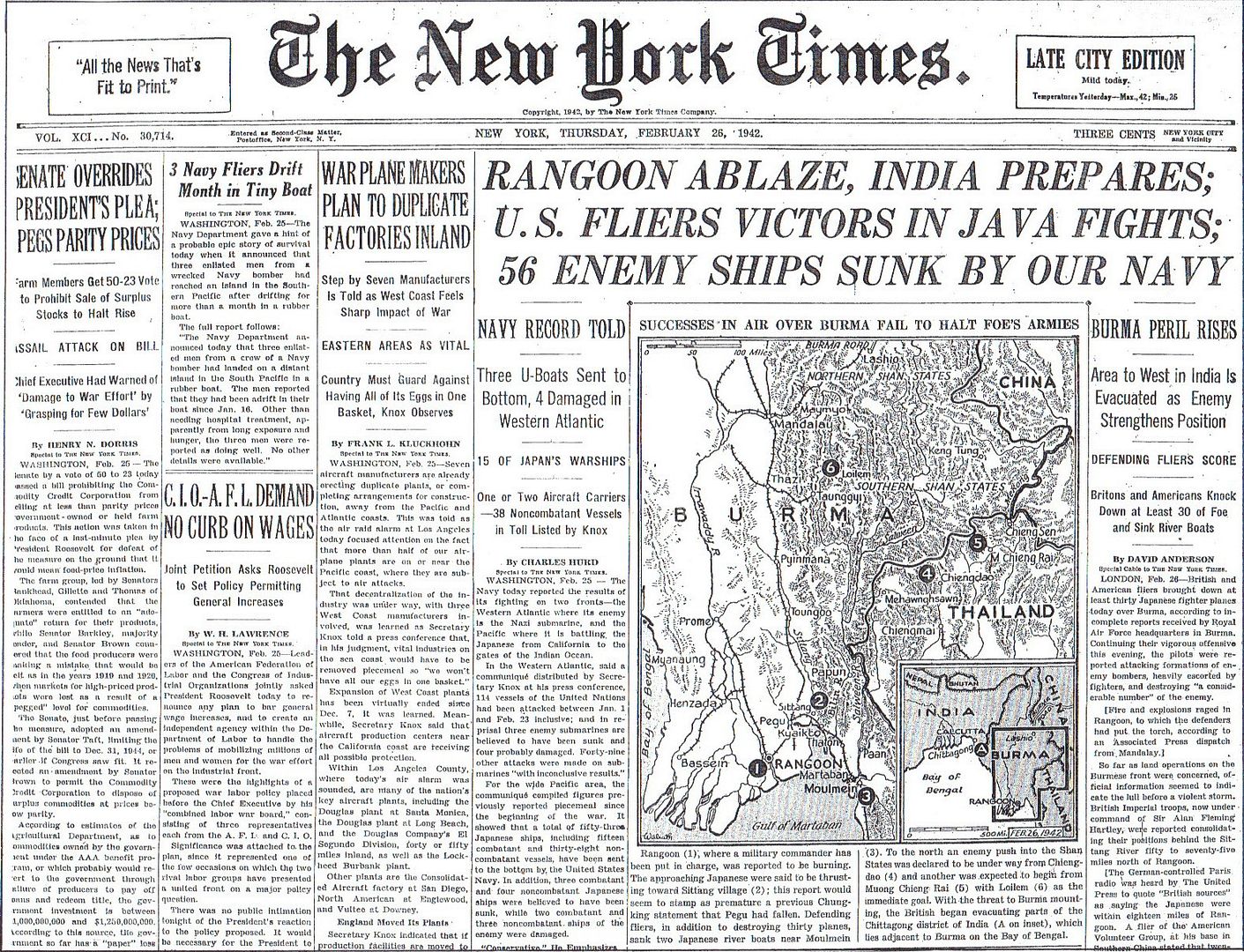
Posted on 02/26/2012 5:15:38 AM PST by Homer_J_Simpson

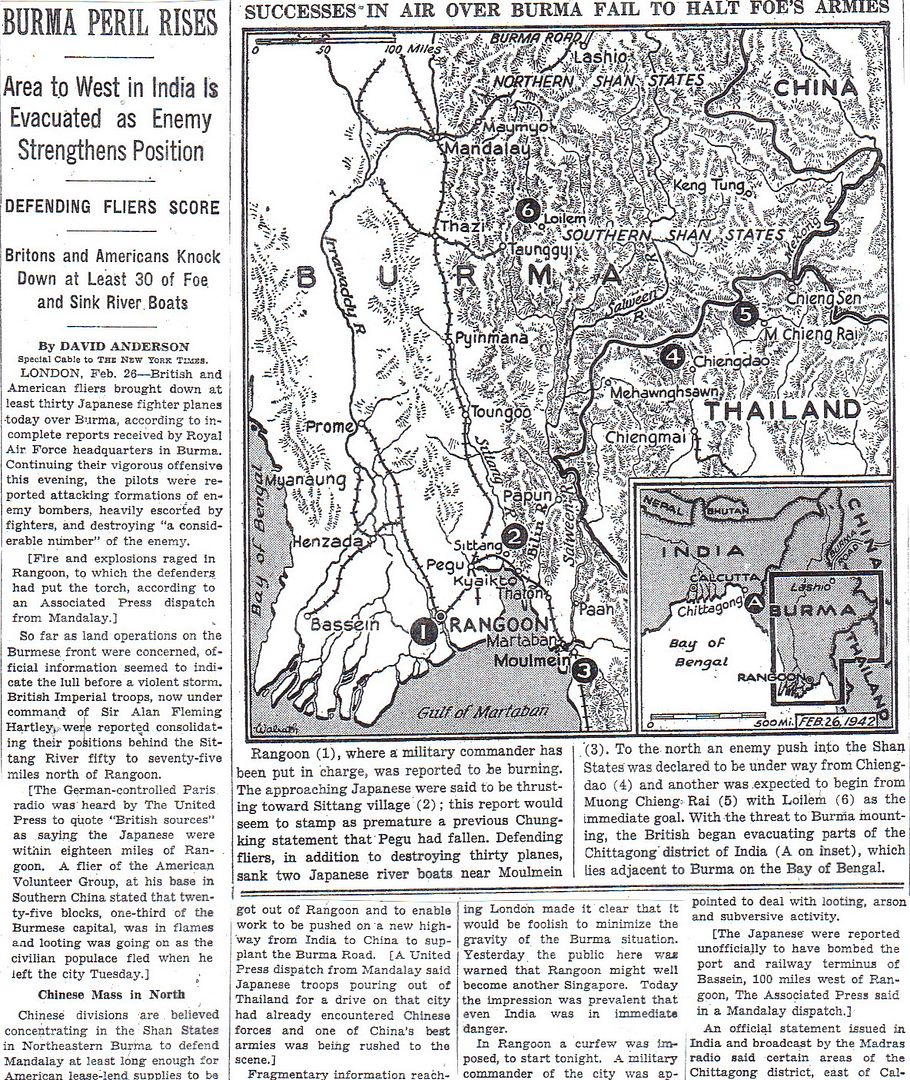
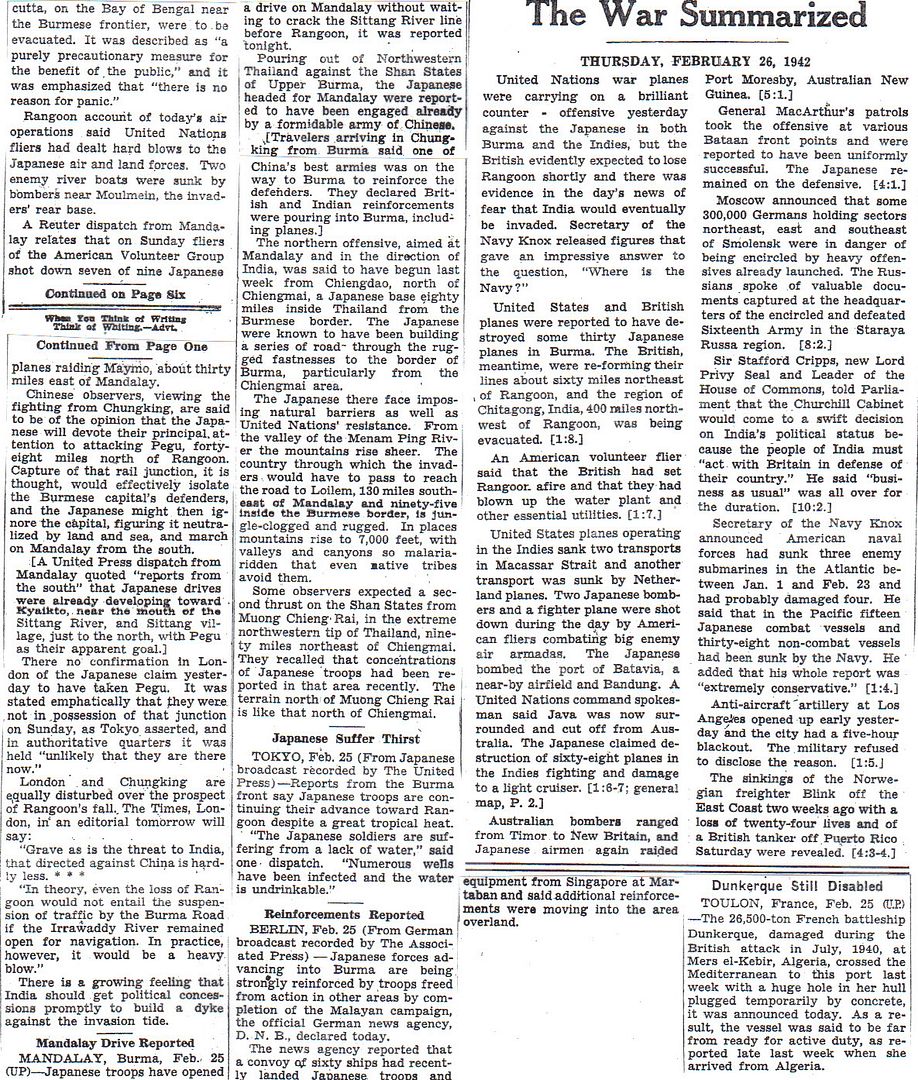
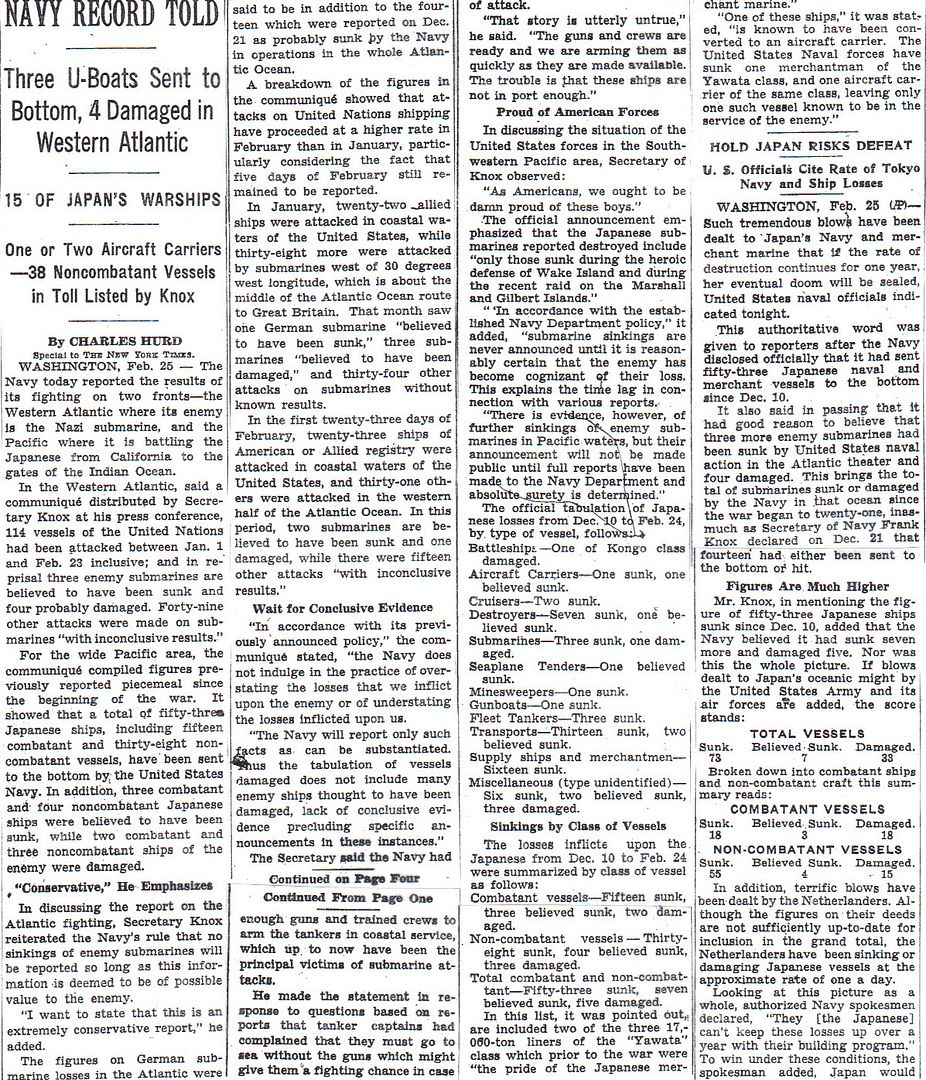
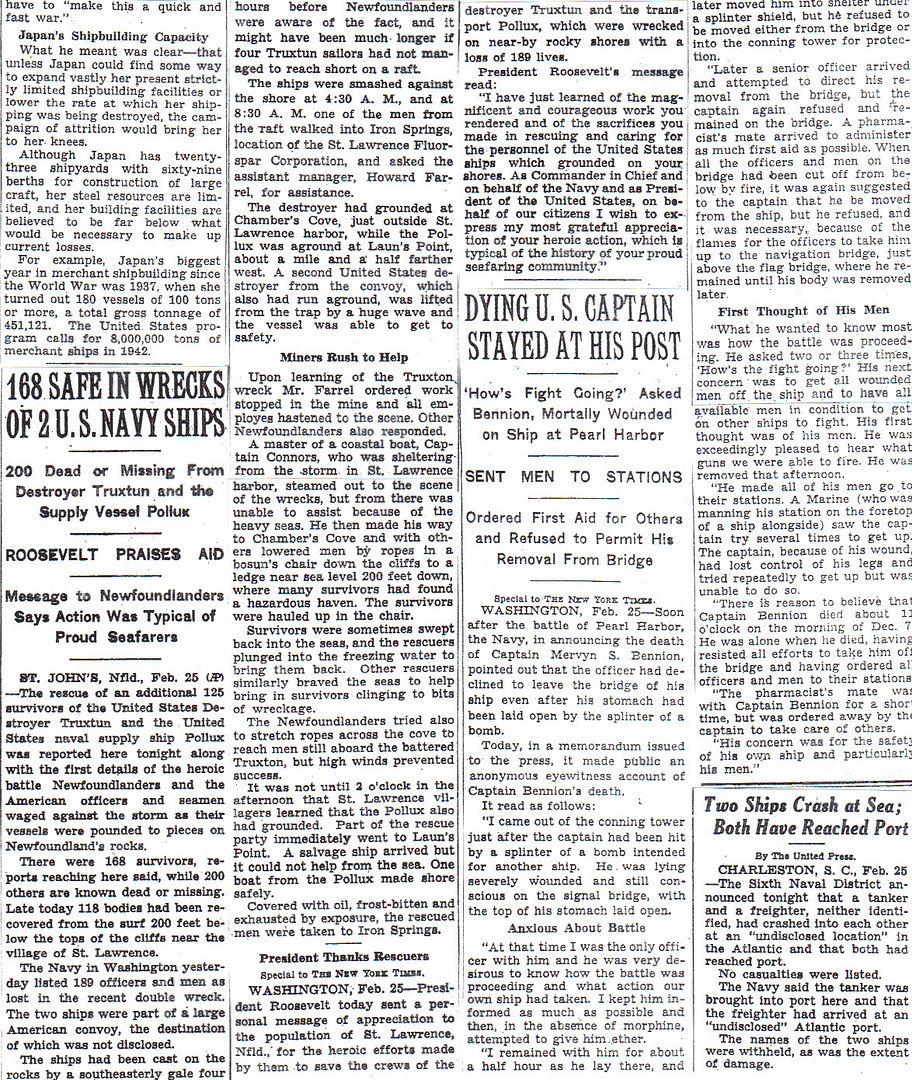
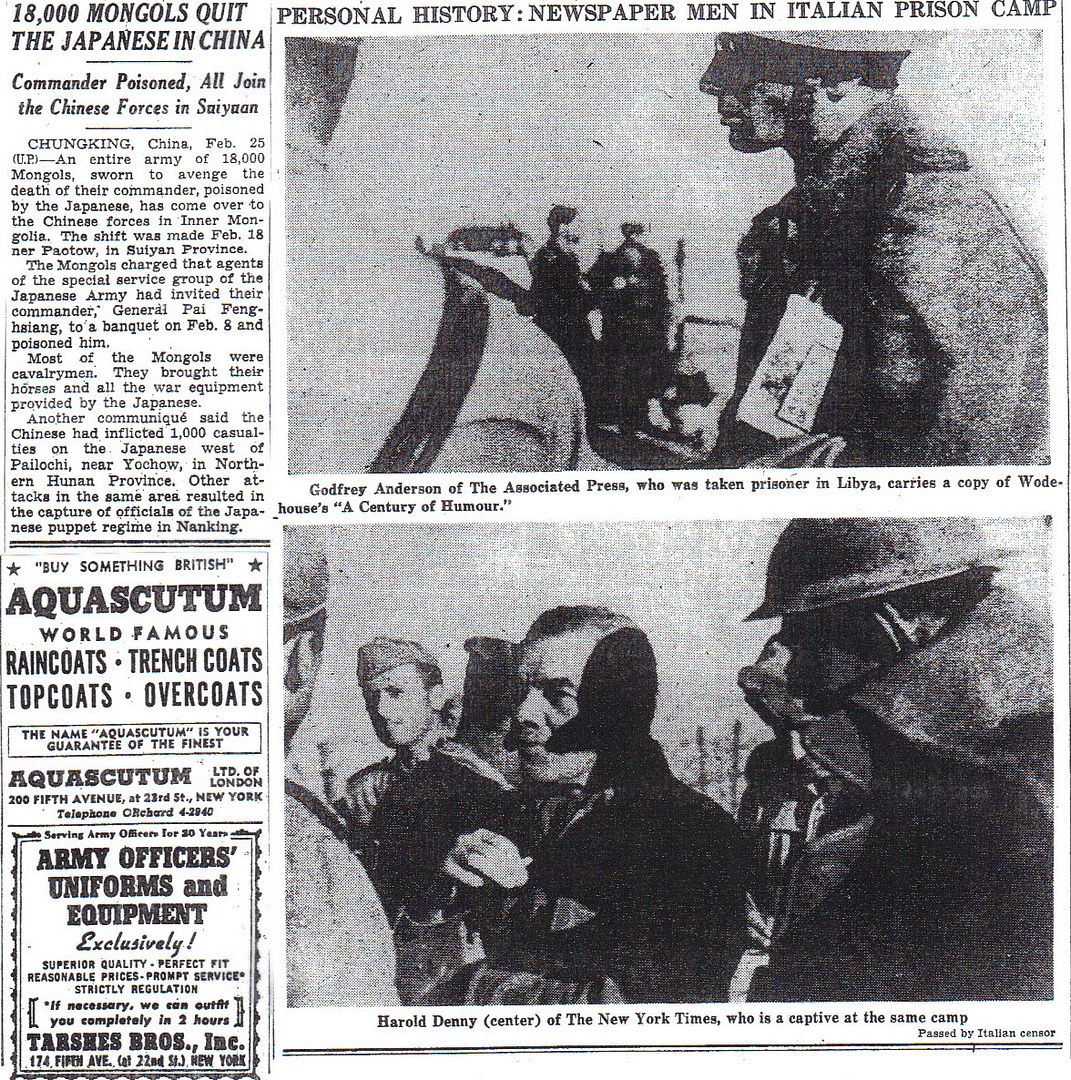
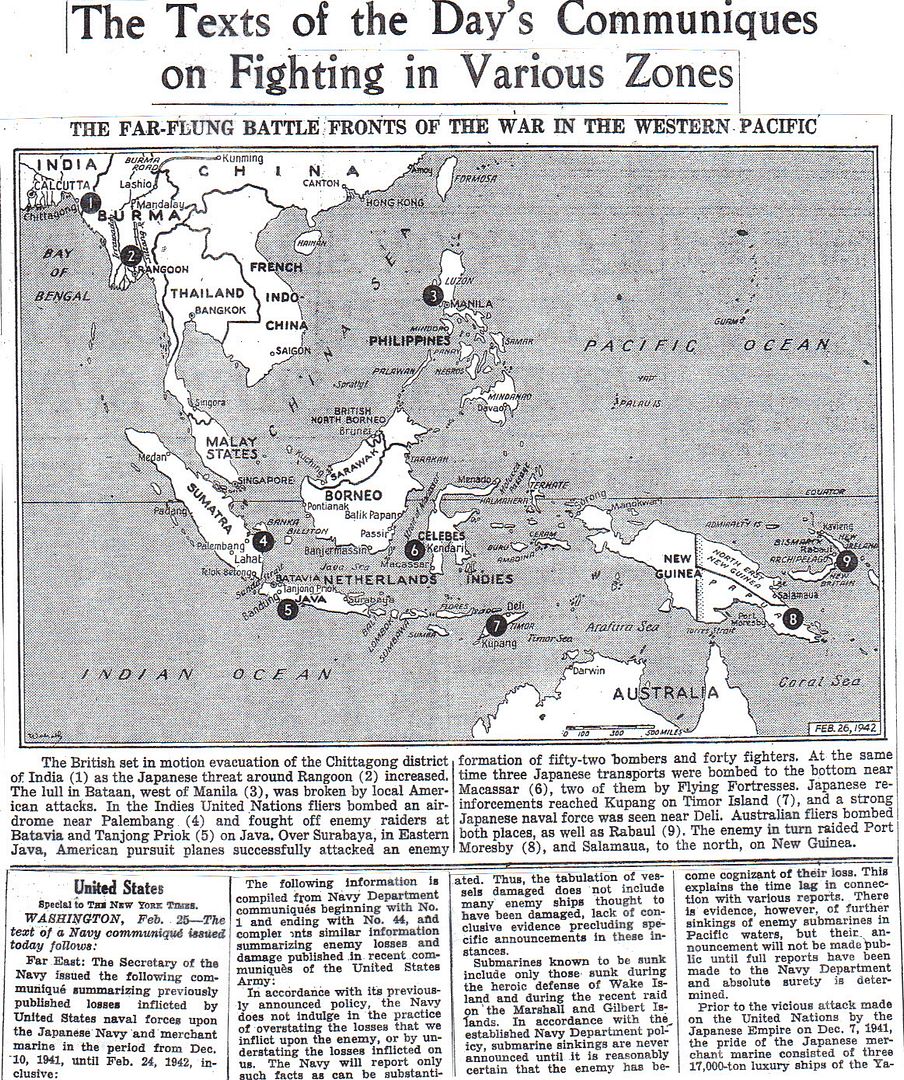


* In case anyone has been wondering what became of our correspondent Harold Denny, captured by the Italians about a week before Pearl Harbor. We still haven't heard from Otto D. Tolischus in Tokyo.
** GSD ping. Note that though this is a picture of five German Shepherds the word German never appears in either the title or the lengthy caption.
http://www.onwar.com/chrono/1942/feb42/f26feb42.htm
Soviet ambassador demands second front
Thursday, February 26, 1942 www.onwar.com
From Washington... Soviet Ambassador Litvinov demands the Allies open a second front. He states that “only by simultaneous offensive operations on two or more of the fronts can Hitler’s armed forces be disposed of.”
On the Eastern Front... The Red Army engages the German 16th Army near Starya Russa, inflicting heavy casualties.
In Burma... the Japanese cross the Sittang River and now threaten to capture the Rangoon-Mandalay railway.
http://homepage.ntlworld.com/andrew.etherington/month/thismonth/26.htm
February 26th, 1942
UNITED KINGDOM: The government outlines a building plan to boost employment and provide cheap housing for all after the war.
Prime Minister Winston Churchill exhorts General Claude Auchinleck, Commander in Chief Middle East Command to launch an offensive against the German and Italian forces that are gathering in front of the Gazala line. He reminds Auchinleck that the longer he waits, the more time General Erwin Rommel will have to rebuild his strength. To this General Auchinleck replies that his intention is to first build up an armored striking force as quickly as possible and strengthen the defenses of the Gazala line. Only then would he mount a major offensive, which he advised Churchill would be in early June. (Jack McKillop)
Destroyer HMS Matchless commissioned. (Dave Shirlaw)
FRANCE:
Paris: Lischka to arrange to deport as a preliminary measure resulting from the Wannsee conference, 1000 Jews already arrested in Paris on Stülpnagel’s orders.
During the night of the 25/26th, two RAF Hampdens drop leaflets on Paris. (Jack McKillop)
GERMANY: During the night of the 25/26th, RAF Bomber Command dispatches 49 aircraft, 33 Wellingtons, ten Hampdens and six Halifaxes, to attack the floating drydock at Kiel; 26 aircraft bomb the target. Crews claimed good results in clear weather with bombs close to the floating dock. A high-explosive bomb scored a direct hit on the bows of the battleship Gneisenau, causing severe damage and killing 116 men in the crew. This proved to be the end of Gneisenau as a fighting unit. Bombing in the town of Kiel destroyed several houses and killed 16 people. Two Wellingtons and a Halifax are lost. Individual aircraft bomb Flensburg and Husum. (Jack McKillop)
British bombers damaged the battle cruiser Gneisenau so badly that she would never sail into battle again, ending the war as a block ship. The Gneisenau was the sister ship to the Scharnhost. It was in port for repairs suffered when she struck a mine. The British, alerted by Ultra as to the damages and location of the Gneisenau, launched the air raid to destroy the German raider. (Michael Ballard)
U-444 launched.
U-611 commissioned. (Dave Shirlaw)
U.S.S.R.: The Soviet Army engages the German 16th Army near Starya Russa, inflicting heavy casualties. (Jack McKillop)
LIBYA: The 13 Corps is responsible for defenses organized in depth over 36-mile (58 kilometer) area from Gazala to Bir Hacheim. 30 Corps prepares defensive positions on the frontier and has a detachment at Giarabub. (Jack McKillop)
BURMA: The Japanese push west of Sittang to threaten the rail link between Rangoon and Mandalay.
Hard fighting is developing in the Waw area, northeast of Pegu, as the Japanese continue infiltration westward from the Sittang River. (Jack McKillop)
Pilots of the American Volunteer Group (AVG, aka, “The Flying Tigers”) shoot down one Japanese Army bomber and 19 Nakajima Ki-27, Army Type 97 Fighters (later given the Allied Code Name “Nate”) over Rangoon between 0800 and 1200 hours. (Jack McKillop)
COMMONWEALTH OF THE PHILIPPINES: A Japanese amphibious force, consisting of an infantry battalion and a field artillery battery, sails from Olongapo, Luzon, for Mindoro Island. (Jack McKillop)
NETHERLANDS EAST INDIES: Submarine USS S-38 (SS-143) bombards the Japanese radio station on enemy-occupied Bawean Island, that had been set up the previous day. (Jack McKillop)
During the late morning, the Japanese Eastern Invasion Force headed for Java from Borneo was found again in the Makassar Strait, by a Dutch Dornier flying boat which shadowed them for several hours. The Dornier then carried out an attack on the destroyer HIJMS Amatsukaze, releasing only one bomb which fell about 500 yards (457 meters) ahead of its intended target. This attack was followed by two USAAF B-17 Flying Fortresses dropping their six bombs from 13.000 feet (3962 meters). Two of the bombs fell some 500 yards (457 meters) short of the destroyer HIJMS Hatsukaze. (Jack McKillop)
At 1830 hours, Admiral Doorman’s Combined Striking Force sets sail from Soerabaja, Java, to carry out a night attack on 30 Japanese transports, escorted by two cruisers and five destroyers, which had been sighted shortly before 1200 hours about 200 miles (322 kilometres) to the north-northeast heading west by south at 10 knots. The striking force consists of heavy cruisers HMS Exeter and USS Houston (CA-30), light cruisers HMAS Perth and HNMS De Ruyter and Java, and destroyers HMS Electra, Encounter and Jupiter, HNMS Kortenaer, and Witte de With, and USS Alden (DD-211), John D. Edwards (DD-216), John D. Ford (DD-228) and Paul Jones (DD-230). The force sets course to the eastward so as to sweep along the north coast of Madoera Island where a landing was thought possible. If no enemy were sighted they intended to sweep back to the west and search the Bight of Toeban. Doorman had originally considered a sweep to the north and northeast, but had decided that, without reconnaissance aircraft, there was a better chance of intercepting the enemy by crossing his line of advance close to his probable landing points. (Jack McKillop)
At 2200 hours, the light cruisers HMAS Hobart and HMS Dragon and Danae sail from Batavia, Java, to search for the Japanese invasion convoy sailing towards the island from the west; the ships return at 1300 hours tomorrow having found nothing. (Jack McKillop)
PACIFIC OCEAN: US Navy flier Don Mason sends message, ‘Sighted sub sank same’ in South Pacific. (Dave Shirlaw)
AUSTRALIA: The Japanese submarine HIJMS I-25 launches a Yokosuka E14Y1, Navy Type 0 Small Reconnaissance Seaplane (later given the Allied Code Name “Glen”), to fly a reconnaissance mission over Melbourne, Victoria. (Jack McKillop)
Minesweeper HMAS Cootamundra laid down. (Dave Shirlaw)
CANADA: Prime Minister MacKenzie King orders the evacuation of all persons of Japanese ancestry from the coastal regions of British Columbia. Some given only 24 hours notice. Cars, cameras and radios confiscated for “protective measures”. Curfew imposed. (Jack McKillop)
Minesweeper HMCS Bayfield commissioned. (Dave Shirlaw)
U.S.A.: The 1941 Academy Awards, hosted by Wendell Wilke, are presented at the Biltmore Hotel in Los Angeles, California. “How Green Was My Valley” wins five awards including Best Picture, Best Supporting Actor (Donald Crisp) and Best Director (John Ford); “Sergeant York” wins two Oscars including Best Actor (Gary Cooper); Best Actress is Joan Fontaine for “Suspicion” and Best Supporting Actress is Mary Astor for “The Great Lie.” (Jack McKillop)
Soviet Ambassador to the U.S. Maxim Litvinov demands the Allies open a second front. He states that “only by simultaneous offensive operations on two or more of the fronts can Hitler’s armed forces be disposed of.” (Jack McKillop)
Destroyers USS Davison and Edwards laid down. (Dave Shirlaw)
ATLANTIC OCEAN: Two U.S. merchant ships are sunk off the U.S. coast by German U-boats:
(1) the 8,125-ton unarmed bulk ore carrier Marore, heading from Chile to Baltimore, is torpedoed, shelled, and sunk by U-432 about 55 miles (89 kilometres) east-northeast of Cape Hattaras, North Carolina, all hands survice;
(2) the Esso armed tanker R.P. Resor (7,451-tons) is torpedoed by U-578 5 miles (8 kilometres) off Sea Girt, Delaware. The ship catches fire and only two men out of 49 are able to escape. (Jack McKillop & Keith Allen)
At 1913, the unescorted tanker Mamura was torpedoed by U-504 about 230 miles off the coast of Florida. One torpedo hit the engine room, while a second detonated in the bow. The tanker was immediately ablaze and broke in two. The U-boat had fired the torpedoes from a distance of 400 meters and had to avoid the burning gasoline by diving. After surfacing eight minutes later, the stern section sank, while the bow was still visible. None of the 49 crewmembers, 35 of them Chinese, survived.
Two days after leaving Trondheim, U-454 lost Matrosengefreiter Josef Kauer overboard. (Dave Shirlaw)
http://en.wikipedia.org/wiki/Karel_Doorman
Karel Willem Frederik Marie Doorman (April 23, 1889 – February 28, 1942) was a Dutch Rear Admiral who commanded ABDACOM Naval forces, a hastily-organized multinational naval force formed to defend the East Indies against an overwhelming Imperial Japanese attack.
Amazing to see how pro military the Dems (and the media) once were... Then the 60s happened.
The only axis aircraft type to bomb the mainland USA.

The "Glenn" also has the distinction of being the only aircraft to drop bombs on the United States mainland during World War II, in an incident known as The Lookout Air Raid. On 9 September 1942 , Chief Warrant Officer Nobuo Fujita, a pilot in the Japanese Imperial Navy, and his crewman, Petty Officer Shoji Okuda, surfaced in submarine I-25 off the coast of Oregon near Brookings. His tiny seaplane had folding wings and was transported in a small hangar attached to the deck of the submarine. The bombs - 76 kg (168 lb) incendiaries intended to cause forest fires - caused no injuries or real damage.
http://www.scharnhorst-class.dk/gneisenau/gallery/gallgneisedestruction.html
The Gneisenau in drydock at Deutsche Werke in Kiel. While under repair the Gneisenau received a direct hit on the foredeck during an air attack on the night of 26 - 27 February 1942. Despite it was standard procedure, her stocks of ammunition were not discharged. This was a fatal error as the hit she received started a chain reaction which devastated the ship and killed 112 crewmembers. This was the end of the career of the Gneisenau.
http://en.wikipedia.org/wiki/German_battleship_Gneisenau
Repair work on Gneisenau was completed by 26 February 1942, and she was scheduled to deploy to Norway on 6 March. Her ammunition stores had been restocked and she was prepared for a short round of trials before her departure. On the night of 26–27 February, however, the British launched a heavy air raid on the ship.[42] The ship was hit by a single bomb in her forecastle that penetrated the armored deck and exploded.[43] Red-hot bomb fragments ignited propellant charges in the forward turret and caused a tremendous explosion. The turret was thrown off its mount and the entire bow section was burned out.[33] The crew partially flooded the magazine to prevent a more catastrophic explosion. The blast killed 112 men and wounded 21 others.[44]
I’ve looked a pictures of the de Ruyter, but don’t get the reference as to the superstructure.
Godzilla camouflage?
Yesterday, I had the great pleasure of catching Col. Ollie North's excellent Fox documentary on the work of war correspondents and photographers throughout the ages.
The program was dedicated to the woman correspondent (patch on her eye) and the photographer who were both killed last week in Syria while doing their media jobs.
I love history, and Ollie's film started with commentary and old photos involving war correspondents and photographers in the Boer and Spanish-American wars, then on to the Civil War, through World Wars One and Two....then Korea, Viet Nam and onward.
Old film clips were manna from heaven for this history buff, especially the ones from WW1 which is my particular area of interest.
If the documentary ever runs again don't miss it. Ollie should get a "best" award for it at some glittering ceremony in the future, and he would if I had my way....but of course, the news and entertainment media has no use for wars, no use for the military, nor any use for the hundreds of brave correspondents and photographers who fearlessly went into the heat of battle over the decades.....and who sadly were killed, were injured, went missing or were captured.
These are the "working stiffs" part of the media I have the greatest respect for. From the Civil War's Matthew Brady, through Ernie Pyle and Edward R. Murrow in WW2, through today's war reporters covering Afghanistan, Syria and other dangerous spots....we're able to see the glory and gore of warfare with our own eyes.....and learn truths and realities that were formerly and sadly never available to countless uninformed generations.
Leni/MinuteGal
Your post prompted me to do a search to find out how Harold Denny made out during the war. He would eventually return to the U.S. But in doing that research I also learned that another Times correspondent familiar to frequent readers here would not return alive. Robert P. "Bob" Post, London correspondent, will go on a mission with an 8th Air Force crew about a year from now - February 1943 - and will not return. Check out his entry in the index on my profile. Post was a stalwart during the Battle of Britain.
Old film clips were manna from heaven for this history buff, especially the ones from WW1 which is my particular area of interest.
Cougar - have you run into any good and accessible WWI footage for Leni during your research?
The headline sounds good, I guess ‘56 ships’ is meant to boost civilian morale

No more odd looking than the superstructures of Imperial Japanese Navy (IJN) cruisers, imo...
If anything, a bit more modern looking than the leftovers from World War I. About the size of a modern destroyer, with an unusual gun arrangement. 3 doubles and one single gun turrets for it’s main batteries (150mm, appx 6 inches).
Thanks. Good find.
Disclaimer: Opinions posted on Free Republic are those of the individual posters and do not necessarily represent the opinion of Free Republic or its management. All materials posted herein are protected by copyright law and the exemption for fair use of copyrighted works.